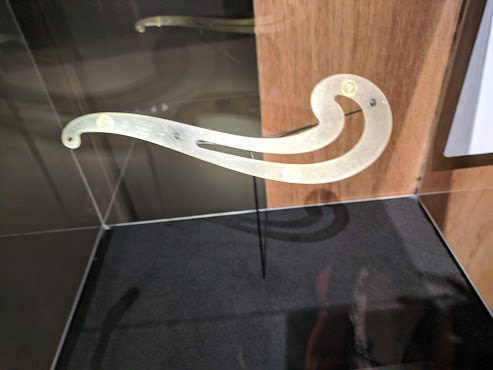The headless voice was a virtual docent. He was posted up in another part of the museum (presumably a quiet and socially distanced one). He said hello and suggested we look for a few specific things during our tour of the new exhibit.
One of the artifacts the virtual docent told us to be on the lookout for was the camera used to take many of the now-famous aerial shots of the attack on Pearl Harbor. We read about photographer Lee Embree ...
and we checked out the Graflex Speed Graphic Camera he used to capture the action at Pearl Harbor on Dec. 7, 1941.1
CJ has this to share about our visit to the museum on Sunday.
Seventy five years ago this year, World War II came to a conclusion following the signing of a peace treaty between the American and Japanese governments. In commemoration of this, The Museum of Flight just unveiled its Untold Stories: World War II at 75 exhibit, presented for public viewing after months of development. Untold Stories marks the first time in 14 years that there have been any major changes to The Museum of Flight's World War II exhibit.
Despite being advertised as an overhaul of the World War II exhibit, large swathes of the exhibit were identical to its pre-renovation status. However, there were some changes I noticed. The first and most obvious one was more of an emphasis on the personal stories of World War II. It was definitely interesting reading more about the individual accounts of soldiers in the war. There was also more of an emphasis on women's World War II stories, especially in sex-segregated combat units.
One of the most novel additions was the "Virtual Docent" at the entrance to the exhibit. A large screen was set up, where a docent calling in via Zoom could talk to us and perform the functions of a typical museum docent.
There were many items of interest for us to ogle, including these flags used on aircraft carriers.
We also checked out some noses and tails.
We read up on helmets and jackets.
The Museum of Flight’s World War 2 exhibit in the Personal Courage Wing recently underwent renovations, just reopening this Saturday. They added a number of more personal stories and items from both soldiers and civilians from multiple countries involved in the war. Some of the new items included the Graflex Speed Graphic Camera owned by Lee Embree – the very same camera that took one of the most iconic images of the attack at Pearl Harbor.There was also expansions and additions to the section of the wing dedicated to the women that flew in the war, including the American WASPs and ATA (Air Transport Auxiliary, who ferried supplies between factories and bases.) Many of the personal stories of women involved in the war were around the exhibit, many of which I had never heard of before. Examples include Margery Watson, one of the many women who worked on designing and drafting plans for new aircraft with the NAA.There’s so much information in the exhibit that there’s no way I could digest all of it in one visit. My family and I plan on making many more trips to the museum to get the full experience, and I would highly recommend doing the same if you’re interested in the history of aviation and how it played such a major role in wars.
We appreciated that the museum included lots of information about the important roles women played in World War II.
Below is as photo of a French curve. Designer Margery Watson used it to draft the under-fuselage of the F-51 Mustang.
Fortunately, that wrong was righted by an act of Congress passed in 1977.


















Great photos and good reports on the renovated exhibit. It does sound like multiple visits will be needed
ReplyDelete